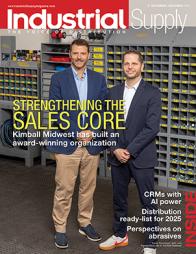E-commerce platform considerations for B-to-B distributors

By Dean Mueller and Jonathan Bein
Questions many B-to-B distributors have relating to e-commerce platform selection often include:
- Why are the adoption rate and revenue low from our existing e-commerce implementation?
- Would our organization benefit from changing or upgrading the current platform?
- Has our digital channel been marketed aggressively?
- What are the key components to take into consideration for an e-commerce platform, or replatform, selection?
Research from our previously published annual 2015 State of
E-Commerce Study shows that more than 41% of distributors are generating less than 5% of revenue through e-commerce and only 4.3% of distributors enjoy 40% or more of revenue through the e-commerce channel.
Many reasons help explain why companies that have a highly mature e-commerce channel are successful. The type of products sold online have a factor, with MRO products generally having higher online adoption. However, the biggest and most important factor for a successful e-commerce adoption – and growth velocity – is having a strong strategic plan for the digital sales channel.
Without a solid digital strategic plan, companies often focus on the technology by selecting the platform and integrating with the ERP.
The most important component in selecting an e-commerce platform is knowing what features and functionality your customers need and expect. Furthermore, understanding when certain features and functionality are needed help build an e-commerce roadmap. The most successful e-commerce implementations for B-to-B distributors continuously evolve with new features to address customer needs, along with
improving conversion rate (CRO, or conversion rate optimization).
The financial payoff to implement (or replatform, if necessary) an e-commerce solution is clear. Annual ROI (after tax) is high and ranges from 250% for a $25M distributor to nearly 600% for a $250M distributor. More information on the ROI and net present value of an e-commerce implementation can be found in our article in the Sept./Oct. 2015 issue of Industrial Supply magazine.
B-to-B distributors find it is much easier and less expensive to implement an e-commerce initiative today than just a few years ago. Early e-commerce implementations were $500,000 to $1 million projects, effectively keeping out all but the largest distributors. Today, even a small to midsize distributor can enter the e-commerce sales channel for a $50,000 to $200,000 investment.
Another factor contributing to the e-commerce ease of entry is the introduction of good e-commerce platforms that have a product information manager (PIM) as an integrated part of the solution. A PIM is the heart of the product data, which is essential to serve existing customers. It can increase the probability of acquiring new customers through better search results, both on the website and search engines, such as Google and Bing.
The survey mentioned above discusses five categories of e-commerce platforms:
- Homegrown – These platforms are developed from scratch, generally with some third-party components, such as a shopping cart, etc. The typical example is a distributor that wants to dip their toes into the digital space. Keeping current with new customer requirements is often a challenge with a homegrown solution.
- ERP-provided portal – The portal provides an e-commerce solution that is already integrated with the ERP system. Deployment is generally quick and the cost is low. These portals typically have limited functionality and ability to customize. Distributors are most dissatisfied with the ERP-provided portals, with 55% saying they are not satisfied.
- Hybrid – This approach may mix homegrown development with open source tools, such as Magento, and combines one of the other platform types. Some distributors used this approach, especially a few years before cost-effective e-commerce solutions were available. While an effective approach at launch, keeping up with evolving requirements is often difficult due to several different software components.
- Mid-market – These platforms have more functionality than an ERP-provided portal and have the added benefit that they are not tied to a specific ERP system. Platforms in this category are available for distributors in the $25M to $750M range.
- Enterprise – These are distinguished by their ease of content management, powerful search, support for multiple sites and complex high-end ERP integrations. Organizations with a minimum of $500M in revenue are generally the entry point for enterprise level e-commerce solutions.
A key factor in e-commerce reboot, or replatform considerations, includes what percentage of total current revenue comes from the e-commerce channel. For a distributor in the nascent stage of less than 5% of revenue coming from e-commerce, that is typically a two- or three-year process. Fewer features are generally implemented in the beginning e-commerce stages.
Reducing the time spent in the nascent stage and moving to the growth and mature stage requires a solid understanding of customer needs so that an appropriate technology roadmap can be implemented. Additionally, strong marketing will have a major impact on compressing the time it takes to go beyond the nascent stage.
The other end of the spectrum is a distributor in the growth or mature e-commerce stage. Continued growth to serve customers may require a replatform initative. The dollars available generally make it easy to justify.
Whether a distributor is getting into e-commerce for the first time or considering an upgrade to the current platform, there are several broad categories of features and functionality to be considered. Again, understanding specifically what your customers expect helps drive what is needed today and down the road.
Key considerations:
- Mobile – Look at your analytics to understand how your customers currently access your site. Couple that with customer research to gain insight into what their needs are. Some end-users are highly mobile-driven and others are more desktop-driven. Regardless, mobile should be considered a table stakes feature. Most e-commerce platforms today use responsive design so that regardless of what device is used to access the site, it will provide an optimized user experience. Google now rewards websites that are mobile-friendly. So, not being optimized puts your company at a disadvantage. You can read more about that impact in this article.
- Pricing flexibility – Once logged in, a platform should have the capability to support customer specific pricing, or CSP. Some platforms also provide the option to show a custom catalog of products based on log-in credentials.
- User management – Most B-to-B distributors need some level of user management, which can include requisition routing and approvals, etc.
- E-procurement – Whether it is EDI or a full punchout system, this capability may be an important consideration. For a distributor starting out, e-procurement may not be a high priority; however, a few major customers or national accounts may expect e-procurement features. E-procurement features and capabilities in e-commerce platforms vary. Understanding customer needs will help guide which platform is right for your organization.
- Personalization – B-to-B distributors that are mature often have functionality that personalizes an experience for the user. Specifically, based on their browsing and/or purchase behavior, different products may be shown for cross-sell and upsell. This capability can have a significant impact to increasing conversions for organizations that are in the growth to mature e-commerce stages. Knowing if personalization is supported and/or how it can be incorporated in the future should go into your platform consideration.
- Customer engagement – Features such as Ratings and Reviews and Ask and Answer can be powerful ways to increase customer engagement. As consumers, we depend on ratings and reviews to make decisions on products we buy. Business purchasers are growing more dependent on similar experiences that they expect in their personal purchasing, making it more important to implement features that can increase customer engagement.
A solid content strategy is also a good way to increase customer engagement. Many distributors have excellent content, such as training, that sets them apart from competitors. Leveraging content on the web can be an excellent tool for your customers. Google and search engines help to extend that to new customers too.
A key consideration for your e-commerce platform is to understand what is involved to add content to the site.
While these e-commerce platform considerations are not exhaustive, they represent a solid foundation.
In summary, e-commerce platform considerations must have the voice of the customer at the foundation. Both qualitative and quantitative research helps distributors to gain a clear understanding of end-user needs. An e-commerce strategic plan and roadmap that includes technology and strong digital marketing can be achieved from the customer research and ultimately guide your e-commerce growth.
Whether it is an initial e-commerce implementation or a replatform initiative, strong marketing will reduce the time it takes to increase revenue from the digital channel. Many distributors have very good expertise on the operational and financial side of the business but little or no experience on the digital side, other than IT resources. If that describes your organization, you will likely benefit by finding an experienced third-party resource that can help your company navigate through the digital waters.
The bottom line is that there is a high ROI available for the smallest to largest distributor. Focus on customer needs and develop the e-commerce roadmap. There is plenty of revenue and profit available to support the e-commerce initiative.
 |
 |
Dean Mueller has more than 30 years experience in sales and marketing, including senior-level positions in marketing and technology leadership in public and private equity organizations. Using market research, Dean has a deep understanding of distributor customer needs.
Jonathan Bein, Ph.D., has worked with many distributors to make their marketing a profit center. He has developed and applied analytic approaches for customer segmentation, customer lifecycle management, positioning and messaging, pricing and channel strategy for distributors.
Contact them at jbein@distributionstrategy.com or visit DistributionStrategy.com.
This article originally appeared in the Nov./Dec. 2015 issue of Industrial Supply magazine. Copyright 2015, Direct Business Media.













